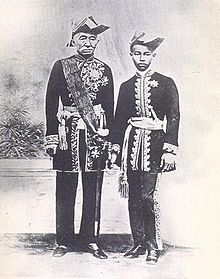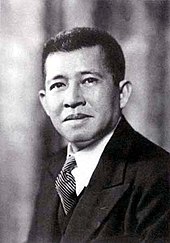Ministry of Foreign Affairs (Thailand)
The Ministry of Foreign Affairs of the Kingdom of Thailand ( Thai : กระทรวง การต่างประเทศ , krasuang kan tang prathet ) is the main government agency for relations between Thailand and abroad.
Organization and administrative structure
1992 most departments attracted the Foreign Ministry in the district Ratchathewi in Bangkok , Sri Ayutthaya Road / Phaya Thai 443. Current Minister Don Pramudwinai , his deputy is Virasakdi Futrakul.
administration
- Ministerial Office
- Office of the State Secretary
- The State Secretary is Busaya Mathelin
Political departments
- Consular Affairs Department
- Protocol Department
- Authority for International Development Cooperation
- Department of Foreign Trade
- Contract and Legal Department
- Information department
- International Organization Department
Regional departments
- European Affairs Department
- Department of American and South Pacific Affairs
- Department for ASEAN (members of the ASEAN group)
- Department of East Asian Affairs
- Department of South Asian, Middle East and African Affairs
history
During the time of the Absolute Monarchy , relations with other countries in Siam were maintained by the respective king, who influenced foreign policy by various means. Ramkhamhaeng of Sukhothai (r. 1279 to 1298) tried to initiate trade with China through tributes , which he regularly sent to the emperor. King Ramathibodi I (r. 1350 to 1369) of the Kingdom of Ayutthaya , which rivaled Sukhothai, carried out an administrative reform that gave the king the central role in the administration, which was divided into four departments: (1) Wiang (the local administration), (2) Wang (yard), (3) Khlang (treasury) and (4) Na (agriculture). Phra Khlang (Thai: พระ คลัง ), the chairman of the treasury - and thus also of foreign trade, was responsible for foreign policy in this order, with the king determining its guidelines.
While the first encounter with Europeans in the form of the Portuguese in 1510 did not have any major influence on the course of Siam's history, this changed in the 17th century when French Catholic missionaries were allowed into the country and sought after the head after the tried and tested model (King Narai , ruled 1648 to 1688) and then convert his subjects. At that time both countries sent legates such as the Siamese Kosa Pan to the court of King Louis XIV , who was a brother of Phra Khlang.
The expansion of trade, which was mostly carried out by sea, later led to the formation of the subdivision of Khrom Tha ( กรมท่า ), which was responsible for the administration of the ports of the empire. But not only merchants came across the sea, but also dangers in the form of colonial interests of European powers that arose at the beginning of the 19th century. Siam under the kings Rama III. (ruled 1824 to 1851) and Rama IV. (ruled 1851 to 1868) were initially able to stay out of the deals that England and France had used in Burma , Malacca , Laos , Cambodia and Vietnam to form their colonial empires. The complete defeat of the Chinese Empire against England led to the realization that Siam would have to rely on itself in order to remain independent.
Relations between German states (the Hanseatic cities of Hamburg, Bremen and Lübeck) and Siam were established for the first time in 1861. Until 1875 Phra Khlang and Khrom Tha remained under the same leadership, so that foreign policy and economic matters were dealt with together. Only King Chulalongkorn (Rama V, ruled 1868 to 1910) created a modern foreign ministry, for which Prince Devawongse ( เทวะ วงศ์ ) was officially responsible since 1885 and remained until his death in 1923. He is considered the father of modern Thai foreign policy and led the country through, among other things, the crisis that was triggered by the Pak-Nam incident , the massive threats to national independence from British and French colonial interests in Indochina and the First World War (1914 to 1918 ). In a long process, he was able to trace back the long-standing privileges of European citizens (and their colonial subjects in Southeast Asia) to the interstate legal claims of citizens abroad.
The Ministry originally consisted of seven departments:
- Ministerial Office (Senabodi)
- Department of the Undersecretary
- Translation agency
- Reception department
- archive
- Billing center
- Diplomatic Department
- Consular Section
Larger and smaller reorganizations led to the current organizational structure (see above), including the establishment of the department for the League of Nations after the end of the First World War. After the overthrow of 1932 , the king was only head according to the Siamese and later Thai constitution , but without absolute violence. Accordingly, the guidelines of foreign policy passed into civil violence, including those of Pridi Phanomyong .
Thai Foreign Minister
An overview of the Thai foreign ministers
- Chao Phraya Phanuwong Mahakosathibodi (Thuam Bunnag ) (1871–1881)
- Prince Devawongse Varopakar (June 12, 1881 - June 24, 1923) is believed to be the originator of the Kingdom's Foreign Ministry tradition
- Prince Devawong's Varodaya (Traidos Prabandh) (April 1, 1924 - June 29, 1932)
- Phraya Sri Visarn Vacha (Srivisarn Huntrakul) (June 29, 1932 - June 24, 1933)
- Phraya Abhibal Rajamaitri (Tom Bunnag ) (September 1, 1933 - September 22, 1934)
- Phraya Phahon Phonphayuhasena (Phot Phahonyothin) (September 22, 1934 - August 1, 1935)
- Phraya Srisena (Srisena Sombatsiri) (August 1, 1935 - February 12, 1936)
- Pridi Phanomyong (February 12, 1936 - December 21, 1938), one of the political leaders behind the 1932 coup that paved the way for today's constitutional monarchy
- Chao Phraya Sridharmadhibes (Chit Na Songkhla) (December 20, 1938 - July 14, 1939)
- Plaek Phibunsongkhram (July 14, 1939 - August 22, 1941, December 15, 1941 - June 19, 1942)
- Direck Jayanama (August 22, 1941 - December 14, 1941)
- Wichit Wichitwathakan (June 19, 1942 - October 18, 1943)
- MR Seni Pramoj (February 2, 1946 - March 24, 1946)
- Thawan Thamrongnawasawat (February 6, 1947 - May 31, 1947)
- Arthakitti Banomyong (May 31, 1947 - November 11, 1947)
- Prince Pridithepphong Thewakun (April 15, 1948 - June 29, 1949)
- Pote Sarasin (October 13, 1949 - March 1, 1950)
- Warakan Bancha (March 1, 1950 - March 28, 1952)
- Prince Narathip Phongpraphan (Wan Waithayakon) (March 28, 1952 - April 23, 1957, January 1, 1958 - October 20, 1958) brought Thailand to the side of the West during the Cold War
- Thanat Khoman (February 10, 1959 - November 17, 1971), mediated the creation of SEATO during the Vietnam War and earned global respect for Thai foreign policy
- Thanom Kittikachorn (December 19, 1972 - October 14, 1973)
- Charunphan Itsarangkun Na Ayutthaya (November 17, 1971 - December 18, 1972, October 16, 1973 - February 21, 1975)
- Chatichai Choonhavan , CTP (March 17, 1975 - April 21, 1976)
- Bhichai Rattakul , DP (April 21, 1976 - October 6, 1976)
- Upadit Pachariyangkun , NDP (October 22, 1976 - February 11, 1980)
- Siddhi Savetsila , SAP (February 11, 1980 - August 26, 1990)
- Subin Pinkayan , SAP (August 26, 1990 - December 14, 1990)
- Arthit Ourairat (December 14, 1990 - February 23, 1991)
- Arsa Sarasin (March 6, 1991 - April 21, 1992, June 16, 1992 - October 1, 1992)
- Pongpol Adireksarn , CTP (April 22, 1992 - June 15, 1992)
- Prasong Soonsiri , PDP (October 2, 1992 - October 25, 1994)
- Thaksin Shinawatra , PDP (October 25, 1994 - February 10, 1995)
- Krasae Chanawongse , PDP (February 16, 1995 - May 19, 1995)
- Kasem S. Kasemsri , NTP (May 20, 1995 - May 27, 1996)
- Amnuay Viravan , NTP (May 28, 1996 - August 14, 1996)
- Prachuab Chaiyasan , CPP (November 29, 1996 - October 24, 1997)
- Surin Pitsuwan , DP (November 14, 1997 - February 17, 2001)
- Surakiart Sathirathai , TRT (February 17, 2001 - March 10, 2005)
- Kantathi Suphamongkhon , TRT (March 11, 2005 - September 18, 2006)
- Nitya Pibulsonggram (October 8, 2007 - February 6, 2008)
- Noppadon Pattama , PPP (February 6, 2008 - July 23, 2008)
- Tej Bunnag (July 26, 2008 - September 3, 2008)
- Saroj Chavanaviraj (September 7th - 9th, 2008)
- Sompong Amornvivat , PPP (September 24 - December 2, 2008)
- Kasit Piromya , DP (December 20, 2008 - August 9, 2011)
- Surapong Tovichakchaikul , PTP (August 9, 2011 - May 7, 2014)
- Thanasak Patimaprakorn (August 30, 2014 - August 19, 2015)
- Don Pramudwinai (since August 19, 2015)
See also
Individual evidence
- ↑ More on this in German-Thai Relations
- ↑ Wyatt (2003), 183
- ↑ http://www.mfa.go.th/main/en/organize/1085 (last accessed on January 21, 2014)
- ^ List of Foreign Ministers
literature
- Monsak Jangariyawong: Thailand in Southeast Asia: a study of foreign policy 1945-1991. Diss. Monash Univ., Melbourne, Australia 2003.
- David K. Wyatt : Thailand: a short history . 2. A. Chiang Mai: Silkworm 2003. ISBN 974957544X .
Web links
- http://www.mfa.go.th/ Pages of the Thai Ministry of Foreign Affairs (in English, last accessed on 23 September 2011)





